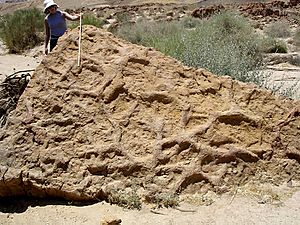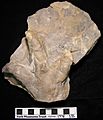Ichnology facts for kids

Ichnology is the study of trace fossils. These are not the actual bones or shells of ancient creatures. Instead, they are signs of what living things did a long time ago.
Think of them as clues left behind by plants and animals. These clues can be burrows, trackways (like footprints), trails, or even holes bored into rocks. By studying these traces, scientists can learn about the behavior of ancient organisms.
A scientist who studies ichnology is called an ichnologist. They research these fossilized clues to understand how ancient life moved, ate, or lived.
Sometimes, a special name is given to a trace fossil. This name is called an ichnospecies. It helps scientists identify and talk about different types of trace fossils.
Contents
What Are Trace Fossils?
Trace fossils show us the activities of ancient life. They are different from body fossils, which are the actual remains of an organism, like a dinosaur bone. Trace fossils tell us about how creatures lived, not just what they looked like.
For example, a dinosaur footprint is a trace fossil. It tells us that a dinosaur walked in that spot. A fossilized worm burrow tells us that a worm once dug through the mud there. These clues help scientists piece together the story of life on Earth.
Examples of Trace Fossils
Scientists have found many amazing trace fossils from different time periods. Each one gives us a peek into the past.
Ancient Footprints
- In the Cambrian period, very old footprints like Protichnites and Climactichnites have been found. These were made by creatures moving in shallow water areas.
- During the Mesozoic Era, dinosaur footprints are common. These include tracks like Grallator and Atreipus, made by two-legged dinosaurs. Anomoepus is another type of dinosaur footprint.
- Possible bird footprints, such as Saurexallopus, also exist.
Burrows and Trails
- Some trace fossils are ancient termite mounds. These can be huge, covering many square kilometers of sediment. They show how complex ancient insect colonies were.
- Thalassinoides are burrows made by ancient crustaceans. These are often found in rocks from the Middle Jurassic period.
- Rusophycus and Skolithos are other types of burrows found in very old rocks, like those from the Ordovician period.
Other Interesting Traces
- Coprolites are fossilized animal droppings. They can show what an animal ate. Some even have bite marks from other creatures!
- Mesolimulus walchi is a rare example where both the fossil of the creature (a horseshoe crab) and its trackway were found together. This helps scientists match the trace to the animal.
- Petroxestes and Trypanites are examples of borings. These are holes made by organisms drilling into hard surfaces, like ancient shells or rocks.
Images for kids
-
Chirotherium footprints in a Triassic sandstone
-
Cross-section of mammoth footprints at The Mammoth Site, Hot Springs, South Dakota
-
This coprolite shows distinct top and bottom jaw bite marks, possibly from a prehistoric gar fish. Discovery location: South Carolina, US; age: Miocene; dimensions: 144.6mm X 63.41mm or 5.7” X 2.5”; weight: 558g (1lbs 4oz)
-
Petroxestes borings in a hardground from the Upper Ordovician of southern Ohio
-
Rusophycus trace fossil from the Ordovician of southern Ohio. Scale bar is 10 mm.
-
Trypanites borings in an Upper Ordovician hardground from northern Kentucky. The borings are filled with diagenetic dolomite (yellowish). Note that the boring on the far right cuts through a shell in the matrix.
-
Ophiomorpha and Thalassinoides trace fossils produced by crustaceans found at Camacho formation from the Late Miocene in Colonia Department, Uruguay
-
Asteriacites (sea star trace fossil) from the Devonian of northeastern Ohio. It appears at first to be an external mold of the body, but the sediment piled between the rays shows that it is a burrow.
-
Numerous borings in a Cretaceous cobble, Faringdon, England; see Wilson (1986)
-
Entobia from the Prairie Bluff Chalk Formation (Upper Cretaceous). Preserved as a cast of the excavations.
-
Helminthopsis ichnosp., a trace fossil from the Logan Formation (Lower Carboniferous) of Wooster, Ohio
-
Lockeia from the Dakota Formation (Upper Cretaceous)
-
Lockeia from the Chagrin Shale (Upper Devonian) of northeastern Ohio. This is an example of the trace fossil ethological group Fugichnia.
-
Inverted trace fossil of an unidentified tridactyl ornithopod
See also
 In Spanish: Icnofósil para niños
In Spanish: Icnofósil para niños




























